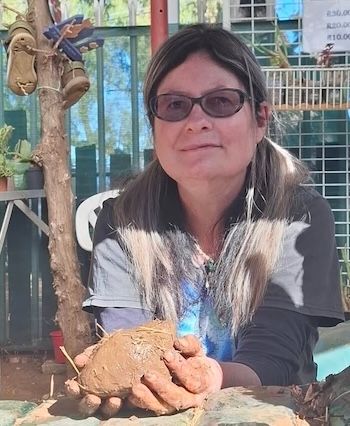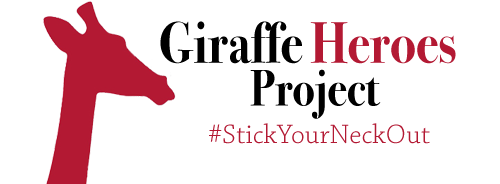Anita Venter

Summary: Anita Venter is a climate activist, decolonial academic, and scholar whose work centers on informal settlement upgrading, culture, Indigenous knowledge, and socio-ecological and regenerative development, with a particular focus on self-help housing. Her journey has been shaped by hands-on experience, including internships with the Earthship Biotecture Academy in Guatemala and the Natural Building Collective in South Africa. Her collaborative efforts with grassroots communities often result in the creation of innovative and creative shelters. Through art, Venter highlights the resilience that communities demonstrate when facing climate and humanitarian crises. Venter often funds her community work herself, sometimes experiences emotional and physical exhaustion, dedicates her weekends to various causes, and perseveres despite continual criticism.
Profile: Anita Venter took a road less traveled, and, though she encountered both skepticism and criticism along her journey, she wound up attaining many of her goals.
Venter, a child of a miner In South Africa, witnessed the harsh realities of an unequal society from a young age. “I grew up in a very unequal society,” she says. “I was aware of people who are more important than others. Even when I was young, I was very much aware of injustice. And within my community, it was always us and them. And that troubled me as a young child. Obviously, as I grew up, I became much more aware of other injustices that went beyond my race.”
Experiencing apartheid, Venter was deeply unsettled by the legacies of colonial domination and slavery: “How can one race be so unjust to other people? This oppressive system came about four hundred years ago in my genes. And people have done so much wrong to other people.” Yet, instead of lamenting, Venter resolved to redress past injustices: “I thought If one race can do so much wrong, we can start to create a counter-narrative—and it starts from within.”
Venter pursued a doctorate, but she soon realized that her artistic abilities were being underutilised in academia. Soon, she saw an opportunity to contribute more directly to housing in marginalised communities. In 2012 she took a break from her studies and co-founded Qala Pelang Tala, a socio-ecological grassroots initiative that uses regenerative building methods to address growing housing challenges in informal settlements. Through the initiative, Venter trained dozens of change agents to become more creative and self-sufficient. “It was to create a platform for the change agents who collaborated and did not have a platform to make their skills flourish,” says Venter. “You train somebody, that person trains you, and then at the end, you do not know who trained who. In the end, people who were part of the movement go out to prepare shelter preparations. It was a celebration of indigenous building technologies.”
At this stage, Venter made a bold decision: “I was almost complete with my Ph.D. in 2013—just a few pages to go. Then I closed the books because I felt uncomfortable with myself. I felt a bit hypocritical.” Seeking a more hands-on approach, Venter traveled to Guatemala in 2013 for an internship on appropriate building technologies with the Earthship Biotecture Academy and Long Way Home. What she experienced there inspired her deeply.
“In Guatemala I had the opportunity to meet 60 volunteers from across the world who had come to build a house for a marginalised family from start to finish. I was fascinated with the process, but even more with the people. People were so open to newness and creativity. In academia, you are not surrounded by a lot of activists. Suddenly, I was with 60 activists who think like me, and I realised maybe I'm not that wrong to see where the gap is in this housing story.”
Returning from Guatemala, Venter sought support from the Natural Building Collective and Peter McIntosh. That collaboration turned into something huge. McIntosh “addressed the technical aspects I was tackling in my Ph.D. in a practical way in Cape Town, while I could do a small-scale project in the Free State. The artistic and human value grew, and community development organically became a method we can almost package now. . . . This is really a team effort. If I had not collaborated with Natural Building Collective, I would not have had the luxury to show what artistic creation can do. That is how my activism started, from my youth, to shelter building and indigenous technologies. Now, I am moving into the artistic sphere, where we are using the same technologies to make public comments and social statements. It’s been a whole evolution of activism.”
Pausing her academics, using art as a way to foster activism, and even pursuing her goals for community development did not always go over well; Venter was often met with negativity. Luckily for her endeavors, she was never particularly interested in being popular, and she is certainly tolerant of opposing opinions, so she has soldiered on. “I often experience emotional and physical exhaustion,” she concedes. “I do get burnout from engaging in so much.” Nonetheless, she has learned to look after herself: “If I have to retreat for a month or so, I do these days because, as an introvert, engagement with people can become really tiring, intense, energy-draining.” Another sacrifice: Committed to her mission and in the absence of sufficient funding, Venter often uses her own resources to cover transport costs to building sites and community workshops.
In 2014, Venter’s creative initiatives caught the attention of Occupational Therapists in Bloemfontein, who specialise in facilitating the health and well-being of patients with physical and mental challenges. Venter: “My biggest story of activism is that Occupational Therapy started to join me, helping with more clinical duties. We are still collaborating by bringing patients to the building sites for rehabilitation. The collaboration became a health exercise, both physically and emotionally, although I facilitate the artistic side.”
Another obstacle: In 2020, the COVID-19 pandemic forced Venter to shut down community development sites. “I worked with immune-compromised people,” she says. “I did not want to have anybody's death on my conscience.”
Venter eventually attained her doctorate. And in September 2024, she co-curated the Jagersfontein Pixels to Perspective exhibition, reflecting on community resilience after a devastating mine disaster:
Anita Venter is happy that, although her community work is intensive, it is a working environment that has given her a voice for advocacy through the arts. She is shifting from “angry activism” to an activism of growth in order to help people “see the world more positively.”
Describing her path to activism, Venter says, “I think some of us are just born activists. It's a deep feeling that comes from within. You cannot do anything else than to act on injustice. I was a little bit born like that. I think activism was born in me just by observing life.”
